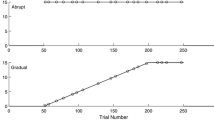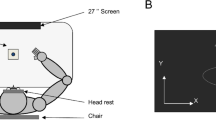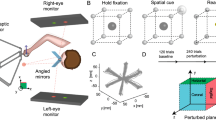Abstract
We recently provided evidence that the dominant and nondominant arms are specialized for controlling different aspects of reaching movements. In this study, we test whether these specializations lead to qualitatively different adaptive mechanisms, when exposed to novel inertial dynamics. Two groups of six right-handed adults performed a reaching task toward a single target with either the dominant or nondominant arm. After 39 trials of task familiarization without a load, subjects performed 180 trials with a 1.5 kg mass, positioned 25 cm lateral to the forearm. To assess the time course of adaptation, we quantified changes in movement direction and linearity, and to assess the quality of adaptation, we randomly interspersed aftereffect trials and generalization trials. The former were assessed by removing the mass and the latter by changing the location of the movement in the workspace. Whereas, final position accuracy improved to the same extent for both arms, initial movement direction improved only for the dominant arm. In contrast, nondominant arm adaptation occurred mainly by making more effective corrections for persistent errors in initial direction. Consistent with these findings, aftereffect trials, an indicator of feedforward control processes, showed progressive increases in error for only the dominant arm. In addition, substantial generalization only occurred for the dominant arm. These results support our hypothesis that interlimb differences in control mechanisms produce different patterns of adaptation to novel inertial dynamics.






Similar content being viewed by others
References
Bagesteiro LB, Sainburg RL (2002) Handedness: Dominant arm advantages in control of limb dynamics. J Neurophysiol 88:2408–2421
Bagesteiro LB, Sainburg RL (2003) Nondominant arm advantages in load compensation during rapid elbow joint movements. J Neurophysiol 90:1503–1513
Bhushan N, Shadmehr R (1999) Computational nature of human adaptive control during learning of reaching movements in force fields. Biol Cybern 81(1):39–60
Bizzi E, Accornero N, Chapple W, Hogan N (1982) Arm trajectory formation in monkeys. Exp Brain Res 46(1):139–143
Bizzi E, Hogan N, Mussa-Ivaldi FA, Giszter S (1992) Does the nervous system use equilibrium-point control to guide single and multiple joint movements? Behav Brain Sci 15(4):603–613
Cisek P, Crammond DJ, Kalaska JF (2003) Neural activity in primary motor and dorsal premotor cortex in reaching tasks with the contralateral versus ipsilateral arm. J Neurophysiol 89(2):922–942
Criscimagna-Hemminger SE, Donchin O, Gazzaniga MS, Shadmehr R (2003) Learned dynamics of reaching movements generalize from dominant to nondominant arm. J Neurophysiol 89:168–176
Feldman AG (1966) Functional tuning of the nervous system with control of movement or maintenance of a steady posture. II. Controllable parameters of the muscles. Biophysics 11:565–578
Feldman AG (1986) Once more on the equilibrium-point hypothesis (λ model) for motor control. J Mot Behav 18:17–54
Gandolfo F, Li C, Benda BJ, Padoa-Schioppa C, Bizzi E (2001) Cortical correlates of learning in monkeys adapting to a new dynamical environment. Proc Natl Acad Sci 97:2259–2263
Geschwind N (1975) The apraxias: neural mechanisms in disorders of learned movements. Am Sci 63:188–195
Gottleib GL (1996) Muscle compliance: implications for the control of movement. Exerc Sport Sci Rev 24:1–34
Gribble PL, Ostry DJ, Sanguineti V, Laboissiere R (1998) Are complex control signals required for human arm movement? J Neurophysiol 79(3):1409–1424
Haaland KY, Prestopnik JL, Knight RT, Lee RR (2004) Hemispheric asymmetries for kinematic and positional aspects of reaching. Brain 127(Pt 5):1145–1158
Hirayama M, Kawato M, Jordan MI (1993) The cascade neural network model and a speed-accuracy trade-off of arm movement. J Mot Behav 25(3):162–174
Kawato M (1999) Internal models for motor control and trajectory planning. Curr Opin Neurobiol 9(6):718–727
Kim SG, Ashe J, Georgopoulos AP, Merkle H, Ellerman JM, Menon RS, Ogawa S (1993a) Functional imaging of human motor cortex at high magnetic field. J Neurophysiol 69:297–302
Kim SG, Ashe J, Hendrich K, Ellerman JM, Merkle H, Ugurbil K, Georgopoulos AP (1993b) Functional magnetic resonance imaging of motor cortex: hemispheric asymmetry and handedness. Science 261:615–617
Krakauer JW, Ghilardi M-F, Ghez C (1999) Independent learning of internal models for kinematic and dynamic control of reaching. Nat Neurosci 2(11):1026–1031
Lackner JR, DiZio P (1994) Rapid adaptation to Coriolis force perturbations of arm trajectory. J Neurophysiol 72:299–313
Lackner JR, Dizio PA (2002) Adaptation to Coriolis force perturbation of movement trajectory; role of proprioceptive and cutaneous somatosensory feedback. Adv Exp Med Biol 508:69–78
Lackner JR, Dizio PA (2003) Adaptation to rotating artificial gravity environments. J Vestib Res 13(4–6):321–330
Laszlo JL, Baguley RA, Bairstow PJ (1970) Bilateral transfer in tapping skill in the absence of peripheral information. J Mot Behav 2:271
Latash ML (1992) Independent control of joint stiffness in the framework of the equilibrium hypothesis. Biol Cybern 67(4):377–384
Liepmann H (1905) Die linke Hemisphäre und das Handeln. Münchener Medizinische Wochenschrift 49:2375–2378
Milner TE, Franklin DW (2005) Impedance control and internal model use during the initial stage of adaptation to novel dynamics in humans. J Physiol 567(Pt 2):651–664
Oldfield RC (1971) The assessment and analysis of handedness: the Edinburgh inventory. Neuropsychologia 9:97–113
Ostry DJ, Feldman AG (2003) A critical evaluation of the force control hypothesis in motor control. Exp Brain Res 221:275–288
Parlow SE, Kinsbourne M (1989) Asymmetrical transfer of training between hands: Implications for interhemispheric communication in normal brain. Brain Cogn 11:98–113
Polit A, Bizzi E (1978) Processes controlling arm movements in monkeys. Science 201:1235–1237
Sainburg RL (2002) Evidence for a dynamic dominance hypothesis of handedness. Exp Brain Res 142:241–258
Sainburg RL, Kalakanis D (2000) Differences in control of arm dynamics during dominant and nondominant arm reaching. J Neurophysiol 83:2661–2675
Sainburg RL, Wang J (2002) Interlimb transfer of visuomotor rotations: independence of direction and final position information. Exp Brain Res 145(4):437–447
Sainburg RL, Ghez C, Kalakanis D (1999) Intersegmental dynamics are controlled by sequential anticipatory, error correction, and postural mechanisms. J Neurophysiol 81:1045–1056
Scheidt RA, Reinkensmeyer DJ, Conditt MA, Rymer WZ, Mussa-Ivaldi FA (2000) Persistance of motor adaptation during constrained, multi-joint, arm movements. J Neurophysiol 84:853–862
Shadmehr R (2004) Generalization as a behavioral window to the neural mechanisms of learning internal models. Hum Mov Science 23:543–568
Shadmehr R, Mussa-Ivaldi RA (1994) Adaptive representation of dynamics during learning of a motor task. J Neurosci 14:3208–3224
Taylor HG, Heilman KM (1980) Left-hemisphere motor dominance in righthanders. Cortex 16(4):587–603
Thoroughman KA, Shadmehr R (2000) Learning of action through adaptive combination of motor primatives. Nature 407(6805):742–747
Thoroughman KA, Taylor JA (2005) Rapid reshaping of human motor generalization. J Neurosci 25(39):48–53
Thut G, Cook ND, Regard M, Leenders KL, Halsband U, Landis T (1996) Intermanual transfer of proximal and distal motor engrams in humans. Exp Brain Res 108:321–327
Wang J, Sainburg RL (2003) Mechanisms underlying interlimb transfer of visuomotor rotations. Exp Brain Res 149:520–526
Wang J, Sainburg RL (2004a) Interarm transfer of novel inertial dynamics is asymmetrical. J Neurophysiol 92:349–360
Wang J, Sainburg RL (2004b) Limitations in interlimb transfer of visuomotor rotations. Exp Brain Res 155(1):1–8
Wang J, Sainburg RL (2006) The symmetry of interarm transfer depends on workspace locations. Exp Brain Res 170(4):464–471
Wolpert DM, Ghahramani Z, Jordan MI (1995) Are arm trajectories planned in kinematic or dynamic coordinates? An adaptation study. Exp Brain Res 103(3):460–470
Acknowledgments
This research was supported by the National Institutes of Health, National Institute of Child Health and Human development grant #R01HD39311. We thank Dr. Toby Mordkoff for scholarly discussions regarding this manuscript and advice regarding statistical analysis.
Author information
Authors and Affiliations
Corresponding author
Rights and permissions
About this article
Cite this article
Duff, S.V., Sainburg, R.L. Lateralization of motor adaptation reveals independence in control of trajectory and steady-state position. Exp Brain Res 179, 551–561 (2007). https://doi.org/10.1007/s00221-006-0811-1
Received:
Accepted:
Published:
Issue Date:
DOI: https://doi.org/10.1007/s00221-006-0811-1




